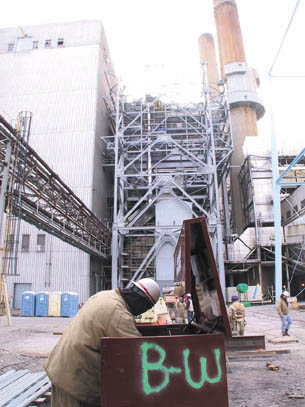Pollution control project brings droves of trades to Consumers plant
Date Posted: December 20 2002
ESSEXVILLE - The Karn-Weadock Generating Complex hasn't seen this much construction activity since the D.E. Karn plant first came on line in 1959.
Owner Consumers Energy, general contractor Babcock and Wilcox, its subcontractors and the building trades are in the midst of finalizing preparations for a major outage affecting D.E. Karn Unit 2, a coal-fired boiler that is being retrofitted with federally mandated pollution control upgrades.
Some 450 Hardhats are currently on the project doing a substantial amount of "preliminary" work before the outage, and more than 900 workers, mostly on two shifts, are expected to toil on the site for the 77-day period beginning Jan. 11 when Unit 2 will be taken off line.
"We started planning for this outage two years ago," said James Ross, outage manager for Consumers Energy. "It's similar to planing for a party. You want everything in place before everyone gets here." The 77-day outage should be some party, but the prep work would be a challenge to any host.
The outage is necessary in part because the federal government has implemented more stringent emission standards for the nation's coal-burning power plants. To meet those standards, Consumers Energy has opted to install a Selective Catalytic Reduction reactor (SCR) in both of its coal-burning Karn units in order to reduce pollutants in the flue stream. The utility declined to reveal the cost of the retrofit.
Installation of the SCR on Karn Unit 2 began in June 2001, and the work is currently about 90 percent complete, said Consumers Energy Program Manager John Gose. More than 2,600 pieces of steel and 74 major duct sections have been installed to support the operation of the SCR, which will be completed and tied in during the outage period.
"The planning has been important, because we've never done anything like this here before," Gose said. "The SCR is a unique piece of equipment." Added Project Manager Ted Webster: "We're working in a 1950s-vintage plant. The designers 50 years ago had no idea we'd be shoehorning in an SCR and the related equipment today."
Working with old drawings on an aging plant, there were bound to be some surprises during such a huge project. "We've had to work around all sorts of obstructions," Gose said. "The best example is a major fire protection water line that supplies the entire complex. We had to dig very carefully around that pipe, because if we broke it or had to shut it down, we would have to shut down the entire complex."
Constructing the SCR has involved the construction of a multi-story support structure, induction draft fans, duct work, and a significant upgrade to the plant's existing electrical system, which couldn't handle the increased load of the SCRs. The building trades are also constructing a urea-to-ammonia manufacturing facility on the site for a vendor, Chemithon. Ammonia - and a lot of it - is used to chemically react with the SCR's catalyst as part of the emissions reduction process, so it makes sense to build a plant on site.
The outage work will also include a partial overhaul of Unit 2's two turbines, installation of a dust removal system, upgrades to the plant's digital control system, installation of a 4160 bus extension and transformers, condenser tube replacement and replacement of reheat inlet tubing.
Outage manager Ross said 3,000 handbooks detailing the project have been printed for distribution to Hardhats. Meetings have been held regularly with the contractors and trades, "so we all understand what's on the agenda," he said. "Everyone is treated as an employee. We're asking the workers to perform on a high level, and we want them to feel comfortable with our goals."
There are 376 Consumers Energy employees at the Karn-Weadock plant, which occupies a small portion of a sprawling 1,000-acre site at the mouth of the Saginaw River on Saginaw Bay. The plant's four coal-fired boilers, two combination oil/natural gas boilers and combustion turbines (peakers) can generate up to 2,138 megawatts of electricity - about one-third of Consumers Energy's capacity.
"We've had a great relationship with the Tri-County Building Trades," Gose said. "The cooperation and quality of work of the building trades workers here has been outstanding. My hat's off to the workers and the contractors out here, there's a lot of people paying a lot of attention to detail, especially when it comes to safety. Our safety record has been phenomenal."
In fact, 260,000 man-hours had been worked without a recordable safety incident."There has been a lot of planning for this project," said Chuck Westphal, a BA for Boilermakers Local 169 and president of the Tri-County Building Trades. "I think they've thought of everything - even down to having a snow removal company on call to make sure we have a place to park. A lot of companies talk about teamwork, but Consumers Energy actually practices what they preach. We couldn't have asked for a better situation."
Speaking of planning, there's already an 86-day outage scheduled for retrofitting the Karn Unit 1 boiler - the tie-in is scheduled for the spring of 2004, and building trades union members expect to be back to do the job.

LOCATING SOME TOOLS in a gangbox on the Consumers Energy Karn-Weadock project is a bundled-up Gavin Brandon of Plumbers and Steamfitters Local 85, working for Babcock and Wilcox. Behind him is the framework for the new selective catalytic reactor being installed on Karn Unit 2.
